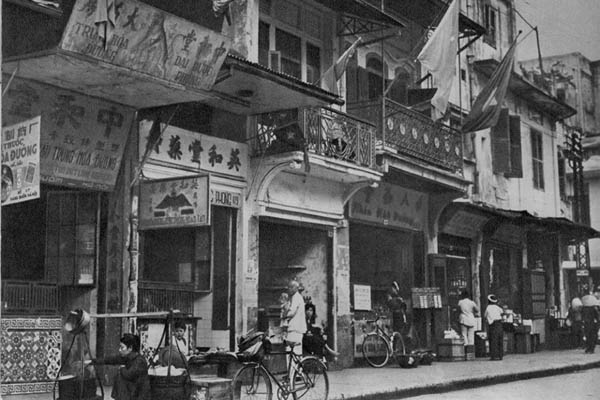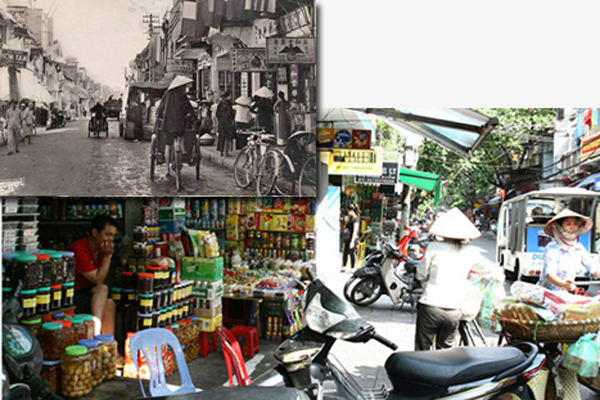In Vietnam the Chinese minority numbers about one million. Most are Hoa, i.e. Chinese who have been naturalized Vietnamese. They live mostly in the South — in HCM City and in provinces of the Cuu Long (Mekong) Delta. In the town of Hoi An in the central part of the country there is a small colony. In the North they live mostly in Quang Ninh, the border region in general, and some major cities. The ancestors of the Hoa came from China in different periods of history, most of them from southern provinces (Guandong, Guangxi, Fujian, Chekiang, Taiwan). Let us note in particular the so-called Minh Huong (in Hoi An and the South), refugees coming in the 17th century to keep their loyalty to the Ming dynasty overthrown by the Qing. Their descendants were to contribute to the exploitation of the Cuu Long (Mekong) Delta and the development of trade in the South.
Hanoi never knew the growth of a China Town like Cho Lon in old Saigon (now HCM City). Up to the outbreak of the Second World War there were only two streets peopled with a Chinese majority and presenting typically Chinese traits (dresses, signboards bearing Chinese ideograms…). They were Pho Hang Ngang (called by the French Rue des Cantonai) prolonged by the famous Pho Hang Dao (Silk Street), and the Pho Hang Buom (in French: Rue des Voiles). Deserted by a large part of the Chinese Diaspora at the end of the First Indochina War (1954) those two streets are nowadays similar to the neighboring ones.
Naturally the royal administration imposed strict rules on the subjects of a constantly threatening Celestial Empire. As early as the 15th century the Chinese were compelled to settle in the present Pho Hang Ngang from which they later spilled into a few neighboring streets, the Pho Hang Bo (Basket Street), the Pho Phuc Kien (Fujian Street) now renamed Lan Ong, and mostly the Pho Hang Buom (Sails Street) in the 19th century. At the expire of their residence permit, the Chinese had to go home unless they preferred to adopt Vietnamese nationality and with it, the country’s dresses, customs and habits, thus becoming Minh Huong. Chinese immigrants were grouped into congregations (bang) according to their provinces of origin, each having its meeting hall (hoi quan), temples and customs. Quite faithful to their native places, they showed great mutual solidarity.

The dominant group in Pho Hang Ngang was the Cantonese community, who evinced a great entrepreneurial spirit. Among it the Phan family (Phan Van Thanh, Phan Hoa Thanh and others) enjoyed extraordinary prestige owing to their large stores of silk fabrics and later the role they played as agents for French textile firms. Lesser Chinese kept shops dealing in tea (imported form China, e.g. from Fujian or Vietnamese tea from Phu Tho, processed the Chinese way) and in traditional drugs (imported from Shanghai, Hongkong, Singapore, Cho Lon) which displayed on their front sign-boards of lacquered wood bearing their names in Chinese characters.
Toward 1927-1930 a boycott of Chinese goods starting from the port of Haiphong spread to Hanoi. Vietnamese-owned ships dealing in silks, drugs, haberdashery appeared in growing number on Hang Ngang Street. The most important Vietnamese trader in silks was a woman Mrs Hoang Minh Ho, whose store at No 48 gave shelter at the start of the 1945 revolution to President Ho Chi Minh, who wrote there the Declaration of Independence of Vietnam. Two members of her family were Cabinet ministers in the People’s Government.
Sails Street (Rue des Voiles in French; Pho Hang Buom Vietnamese) became a major Chinese settlement after the French conquest. In 1872 when the French trader Jean Dupuis, an adventure supported by Paris, penetrated into the capital with his troops made up of Chinese pirates called Yellow Flags and Yunnanese mercenaries he had at his disposal a fifth column recruited among Chinese traders in the Rue des Voiles, who supplied him. In the two French assaults on Hanoi, in 1873 and 1882, Vietnamese streets were ransacked by French troops while Chinese streets remained untouched. The beginnings of French colonization saw the fortune of Chinese settlers. Vietnamese families had to move to other streets. Until the first French war of re-conquest in 1946 the right-hand side of the Rue des Voiles was occupied by the offices of Chinese agents working for Hongkong and Shanghai, goods depots, the seat of the congregation of settlers from Guangdong (Quang Dong Hoi Quan) where were worshipped the warrior Quan Cong of the period of the Three Kingdoms and Queen Thien Hau of the Chinese Sung dynasty fleeing from Mongol invaders. The first movie house of the town was built there too called the Family, its Chinese owner showed films from Hongkong and American Westerns. The movie house was frequented by children and impecunious people, tickets being very cheap and spectators being seated on both sides of the screen, in front and behind.

The left-hand side of the street was mostly occupied by shops selling Chinese drugs, roast meat (pork, chicken), foods imported from China (various sauces, shark finns, bean curd) several restaurants famous for their Chinese dishes (such as the ones named Dong Hung Vien and My Kinh) and the habit taken by their waiters to shout to the kitchens the orders given by the customers.
Less numerous Chinese colonies occupied part of two Vietnamese stress: Phuc Kien and Basket streets. Phuc Kien street was the authorized quarters of Chinese settlers from Phuc Kien (Fujian) who built there their congregation and kept shops holding the monopoly of medicinal drugs imported from Hongkong and Shanghai. Toward 1925 a Vietmmese claiming to be from Chinese stock of Fujian, named Pho Gia Tuong, succeeded in obtaining the right to directly import Chinese drugs and built a family of traditional physicians and druggists of high repute. Phuc Kien street now bears the name of the famous Vietnamese physician Lan Ong. Basket street (Pho Hang Bo) was the home of Chinese settlers from Trieu Chau (a province of Fujian) who practised mostly wholesale trade. They acted as export and import commission agents in the purchase and sale of traditional drugs, silks, matches, essences, tea, mats, areca nuts, sugar, oranges from Trieu Chau…
Small as it is the Chinese diaspora live as a close group and nurtured a great-nation complex with regard to the Vietnamese, Chinese women would not marry Vietnamese men. On the contrary new Chinese arrivals received help and support from their compatriots, worked very hard and often married a disinherited Vietnamese woman (who could double as a servant) after succeeding in opening a small business. The Chinese introduced a number of their divinities: The God of Wealth (Than Tai) and the above-mentioned warrior Quan Cong were honored in every household; the man who vanquished our national heroines, the Trung sisters who raised the standard of revolt against Chinese rule in the early years of the Christian era, Ma Vien, was worshipped at the White horse, (Bach Ma) temple; General Sam Nghi Dong, defeated by Vietnamese troops in 1789, was shipped in a temple built in Sam Cong Lang.



